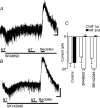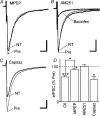Neurotensin inhibition of GABAergic transmission via mGluR-induced endocannabinoid signalling in rat periaqueductal grey
- PMID: 19359367
- PMCID: PMC2714017
- DOI: 10.1113/jphysiol.2008.167429
Neurotensin inhibition of GABAergic transmission via mGluR-induced endocannabinoid signalling in rat periaqueductal grey
Abstract
Neurotensin modulates pain via its actions within descending analgesic pathways which include brain regions such as the midbrain periaqueductal grey (PAG). The aim of this study was to examine the cellular actions of neurotensin on PAG neurons. Whole cell patch clamp recordings were made from rat midbrain PAG slices in vitro to examine the postsynaptic effects of neurotensin and its effects on GABA(A) mediated inhibitory postsynaptic currents (IPSCs). Neurotensin (100-300 nM) produced an inward current in subpopulations of opioid sensitive and insensitive PAG neurons which did not reverse over membrane potentials between -50 and -130 mV. The neurotensin induced current was abolished by the NTS1 and NTS1/2 antagonists SR48692 (300 nM) and SR142948A (300 nM). Neurotensin also produced a reduction in the amplitude of evoked IPSCs, but had no effect on the rate and amplitude of TTX-resistant miniature IPSCs. The neurotensin induced inhibition of evoked IPSCs was reduced by the mGluR5 antagonist MPEP (5microM) and abolished by the cannabinoid CB(1) receptor antagonist AM251 (3 microM). These results suggest that neurotensin produces direct neuronal depolarisation via NTS1 receptors and inhibits GABAergic synaptic transmission within the PAG. The inhibition of synaptic transmission is mediated by neuronal excitation and action potential dependent release of glutamate, leading to mGluR5 mediated production of endocannabinoids which activate presynaptic CB(1) receptors. Thus, neurotensin has cellular actions within the PAG which are consistent with both algesic and analgesic activity, some of which are mediated via the endocannabinoid system.
Figures





References
-
- Behbehani MM, Pert A. A mechanism for the analgesic effect of neurotensin as revealed by behavioral and electrophysiological techniques. Brain Res. 1984;324:35–42. - PubMed
-
- Boudin H, Pelaprat D, Rostene W, Beaudet A. Cellular distribution of neurotensin receptors in rat brain: immunohistochemical study using an antipeptide antibody against the cloned high affinity receptor. J Comp Neurol. 1996;373:76–89. - PubMed
-
- Chen L, Yung KKL, Yung WH. Neurotensin selectively facilitates glutamatergic transmission in globus pallidus. Neuroscience. 2006;141:1871–1878. - PubMed
-
- Clineschmidt BV, McGuffin JC. Neurotensin administered intracisternally inhibits responsiveness of mice to noxious stimuli. Eur J Pharmacol. 1977;46:395–396. - PubMed
Publication types
MeSH terms
Substances
LinkOut - more resources
Full Text Sources
Molecular Biology Databases

